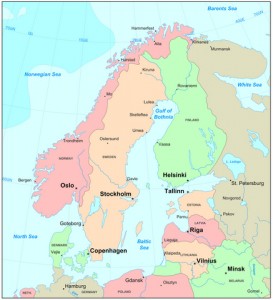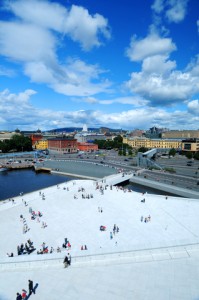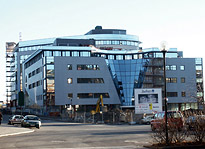
[Updated Oct 2020] A guide to serviced offices and office space for rent in Oslo as well as general information that may be useful if you are thinking of renting office space in Oslo.
For further offices information or to search office space for rent in Oslo just click. Or contact us for any other query.
History & Geography
Norway’s capital is located on an arc of land on the northernmost point of the Oslofjord, which itself is almost cut in half by the Nesodden Peninsula opposite. Oslo itself is typical of the unique Norwegian geography, surrounded by beautiful rolling green hills and forests and with 40 islands and 343 lakes within the city limits. The city was founded around 1049 by King Harald Hardrade and has been regarded as the capital city of Norway since King Hakon V became the first king to reside permanently in the city in the early 14th century. Hakon V also built Akershus Fortress in Oslo, enhancing the city’s strategic value. It was said that whoever held Akershus also ruled Norway. In the 15th century, Norway joined with Denmark and Oslo’s role was cut back politically, however, the city continued to gain in importance as a centre of commerce. During the 16th and 17th centuries, the city was almost completely destroyed by fire several times and was also ravaged by plague, however, it was always rebuilt and continued to prosper from trade and shipbuilding, an industry in which Oslo became prominent. And when the union with Denmark broke up in 1814 the city regained its status as the capital of Norway. The 19th century saw Oslo expand further and many important landmarks built, such as the Royal Palace, Stortinget and the National Theatre. This period also saw many famous artists settling in Oslo such as Henrik Ibsen and Knut Hamsun. In the 20th century many suburbs grew up on the outskirts of the city and the municipality of Aker was incorporated into the city. During the same period the city opened its first metro line and in 1950 Oslo City Hall was opened.
Economy
Oslo has a thriving economy, much of which is based around the maritime industry. Some of the world’s largest shipping companies, shipbrokers and insurance brokers have their headquarters in the city and it has become Europe’s leading centre of maritime knowledge. One of the three major maritime classification societies in the world, Det Norske Veritas, is headquartered in Oslo and the city’s port is the largest cargo and passenger port in the country. Over six million tones of cargo pass through the port annually, as well as more than five million passengers. Also very predominant in Oslo is the oil and gas industry. The city is the centre of Norwegian energy research and offshore petroleum development. Alone Oslo is responsible for approximately 17 percent of the GDP of Norway. However, the city is also well-known as one of the most expensive in the world. Prices of goods and services, as well as property, remain among the highest, rivalling cities such as London, Moscow and Paris. Nevertheless, Oslo is also consistently ranked as among the greenest cities in the world and is a world leader in sustainable technology. The city is also usually ranked among the most livable cities in Europe.
 Tourism
Tourism
Oslo is not among Europe’s foremost tourist destinations, however, has become more popular of late for city breaks, especially among Europeans. Oslo is attractive to visitors for both its cultural and historical sites as well as its natural environment. Famous artist Edward Munch donated all his works to the city and many, including the Scream can be seen in the Munch Museum. There are a number of museums located around the city, the foremost being the Viking Ship Museum, the Oslo City Museum, the National Museum, and the Kon-Tiki Museum, which holds records and the actual ships from famed Norwegian explorer Thor Heyerdahl’s expeditions. Oslo also hosts a large number of festivals and other events, the most popular being rock and roll concert Oslo Live, and the Oya Festival, which annually draws approximately 600,000 people and lasts for four days. The Nobel Peace Prize Ceremony is also held in Oslo every year and takes place in the City Hall. Oslo is also famous for its many parks and green areas located in the city. Frogner Park is located close to the city centre and is the largest and most famous park in Norway, followed by Bygdoy, which is surrounded by the sea on all sides and is Oslo’s most expensive district.
Transportation
Oslo is one of the most compact cities in Europe and is very easy to get around by public transportation. The Oslo Metro and the Oslo Tramway cover most of the city between them, and the city is easily accessible by bike, a popular mode of transport among residents of Oslo. Oslo Central Station offers services to other major cities in Norway as well as Stockholm and Gothenburg in Sweden. Oslo also runs daily ferry services to Copenhagen, Frederikshavn and Kiel. The city is served by the Oslo Airport Gardermoen, located about 29 miles from the city centre and accessible by the Airport Express Train.
 Office space to rent in Oslo
Office space to rent in Oslo
Currently, Oslo has a vacancy rate of approximately seven percent and demand is still healthy. Most of the recent leasing activity in Oslo has taken place in the CBD or the western fringes of the city. Much of the leasing was driven by the public sector. Demand is expected to increase still further over the rest of the year as Oslo’s employment gradually improves. Prime rents currently stand at NOK 3,600 per square metre per year and are expected to continue climbing into the new year.
Our office space search, advisory and acquisition services are FREE, always. Our Oslo office space brokers and agents are globally regulated by the Royal Institution of Chartered Surveyors (RICS) ensuring the highest standards of commercial property advice and service at all times.

The Office Providers is Regulated by the RICS